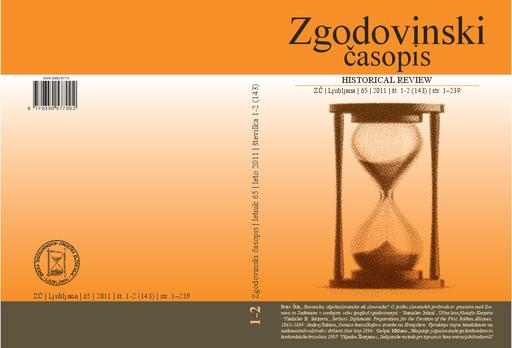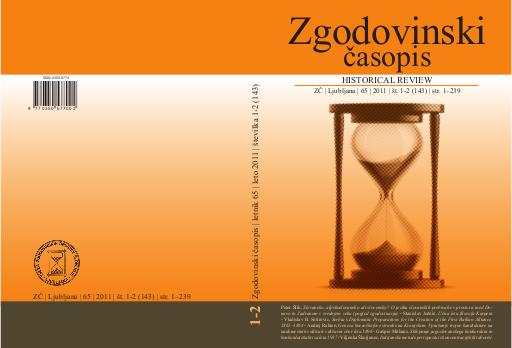/
Serijske publikacije
/
Zgodovinski časopis
Sklepanje jugoslovanskega konkordata in konkordatska kriza leta 1937

Avtor(ji):Gašper Mithans
Soavtor(ji):Peter Štih (odg. ur.), Dušan Mlacović (ur.), Bojan Balkovec (teh. ur.), Nives Sulič Dular (prev.), Neva Makuc (prev.), Stanislav Južnič (prev.)
Leto:2011
Založnik(i):Zveza zgodovinskih društev Slovenije, Ljubljana
Jezik(i):slovenščina
Vrst(e) gradiva:besedilo
Ključne besede:jugoslovanski konkordat, Kraljevina Jugoslavija, Rimskokatoliška cerkev, Srbska pravoslavna cerkev, konkordatska kriza, Yugoslav concordat, Kingdom of the Serbs, Croats, and Slovenes/Yugoslavia, Roman Catholic Church, Serbian Orthodox Church, concordat crisis
Avtorske pravice:

To delo avtorja Gašper Mithans je ponujeno pod Creative Commons Priznanje avtorstva-Nekomercialno-Deljenje pod enakimi pogoji 4.0 Mednarodna
Datoteke (1)

Ime:ZC_2011_1-2.pdf
Velikost:5.59MB
Format:application/pdf
Stalna povezava:https://hdl.handle.net/11686/file18352
Opis
Avtor v prispevku prikaže odnos med Rimskokatoliško
cerkvijo (RKC ) in Kraljevino Jugoslavijo
skozi proces urejanja pravnega statusa
RKC do izbruha t. i. konkordatske krize leta
1937, s čimer je bila zaustavljena ratifikacija
konkordata. Z vpogledom v diplomatske vire o
usklajevanju jugoslovanske vlade pri »zadnjem«
predlogu konkordata (1935) avtor opozori na
»sporna« vprašanja, ki so sprožala nezadovoljstvo
tudi leta 1937. Nerešene točke so se dotikale
vprašanj političnega vpliva in moči, položaja
različnih narodnosti in verskih skupnosti ter
kanonskega in ustavnega prava.
Metapodatki (12)
- identifikatorhttps://hdl.handle.net/11686/35012
- naslov
- Sklepanje jugoslovanskega konkordata in konkordatska kriza leta 1937
- Preparations for the Yugoslav Concordat and the Concordat crisis of 1937
- ustvarjalec
- Gašper Mithans
- soavtor
- Peter Štih (odg. ur.)
- Dušan Mlacović (ur.)
- Bojan Balkovec (teh. ur.)
- Nives Sulič Dular (prev.)
- Neva Makuc (prev.)
- Stanislav Južnič (prev.)
- predmet
- jugoslovanski konkordat
- Kraljevina Jugoslavija
- Rimskokatoliška cerkev
- Srbska pravoslavna cerkev
- konkordatska kriza
- Yugoslav concordat
- Kingdom of the Serbs, Croats, and Slovenes/Yugoslavia
- Roman Catholic Church
- Serbian Orthodox Church
- concordat crisis
- opis
- Avtor v prispevku prikaže odnos med Rimskokatoliško cerkvijo (RKC ) in Kraljevino Jugoslavijo skozi proces urejanja pravnega statusa RKC do izbruha t. i. konkordatske krize leta 1937, s čimer je bila zaustavljena ratifikacija konkordata. Z vpogledom v diplomatske vire o usklajevanju jugoslovanske vlade pri »zadnjem« predlogu konkordata (1935) avtor opozori na »sporna« vprašanja, ki so sprožala nezadovoljstvo tudi leta 1937. Nerešene točke so se dotikale vprašanj političnega vpliva in moči, položaja različnih narodnosti in verskih skupnosti ter kanonskega in ustavnega prava.
- The article focuses on the relations between the Holy See and the Kingdom of the Serbs, Croats, and Slovenes/Yugoslavia. It analyzes the process of the regulation of the legal status of the Roman Catholic Church prior to the outbreak of the so-called concordat crisis of 1937 that brought the ratification of the concordat to a standstill. An investigation of diplomatic documents and harmonization attempts of the Yugoslav government concerning the “last” draft of the concordat in 1935, draws attention to controversial issues that triggered public discontent even in 1937. The unsolved questions dealt with the issues of political influence and power; the position of Yugoslav nationalities and religious communities; and canon and constitutional law.
- The Kingdom of the Serbs, Croats, and Slovenes/Yugoslavia had as many as six types of religious legislation, which resulted in legal chaos over the area of operation of the Roman Catholic Church. In order to regulate the relations between the state and the Holy See a new concordat was proposed. Yet it was never realized despite international appeals, the efforts of King Alexander, several proposals, and negotiations. Insecurity and repressed conflicts between the Roman Catholic Church and the Serbian Orthodox Church on the one hand and between the conflict between Serbia and Croatia on the other were put to profitable use by the radical right wing and by other opposition parties whose principal aim was to replace the government of Milan Stojadinović. A result of several years of diplomatic negotiations, the legal/diplomatic act became politicized, eliciting strong religious and national responses from the masses, and particularly from the Serbian population. The heated emotions resulted in a number of incidents, most notably the krvava litija, the Bloody Liturgy. The death of Serbian patriarch Varnava further aggravated the situation. Of particular interest were the printed so-called legal brochures that were one of the means of the “war propaganda.” They gave the impression of expert substantiations of either the adequacy or the inadequacy of the concordat proposal. A comparison of concordat negotiations in 1933 and 1934 as well as critical evaluations during the period of the concordat crisis reveals a pattern of recurring controversies. These focused on the discord on the operation of religious orders, congregations, and religious schools; on the potential rivalry of the Catholic Action with the Sokol; on marriage regulations; and on depolitization of active clergy (including that of other denominations). It is rather surprising that the unrest of the Serbian public did not trigger a more resolute response in the areas of Yugoslavia with the predominantly Roman Catholic population. The largest Croatian political party refused to get involved in concordat issues, and the Yugoslav Roman Catholic bishops (merely) appealed for a peaceful resolution of the conflict. In addition, the Serbian population no longer trusted either Dr. Anton Korošec, the Minister of the Interior of the day, or Regent Pavle Karadjordjević. In view of this, the Serbian opposition and the Serbian Orthodox Church set to fight the battle against the Holy See by themselves yet on behalf of all Yugoslav nations. Fighting for the constitutional right to the granting of equivalence of all officially recognized religious beliefs, which would be violated by the proposed concordat, they also fought against the government that would permit this. The article focuses on political, religious, and national motifs for the struggle against the concordat as well as on the reasons for its abolition. This was yet another failure of the state to efficiently solve legal as well as domestic and foreign political issues.
- založnik
- Zveza zgodovinskih društev Slovenije
- datum
- 2011
- tip
- besedilo
- jezik
- Slovenščina
- jeDelOd
- pravice
- licenca: ccByNcSa
